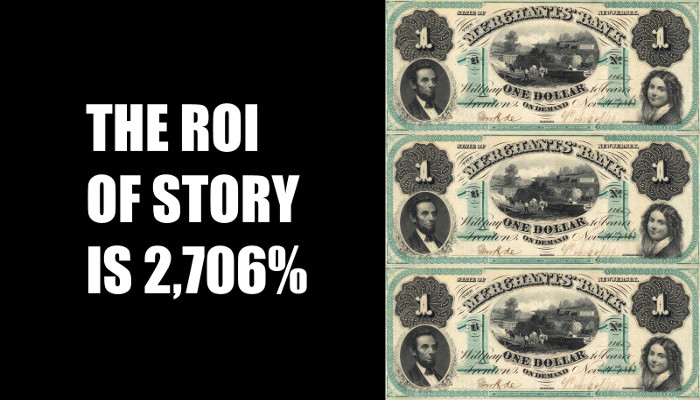
Before I narrowed my focus on storytelling, I used to talk about the broader topic of content marketing. At the time, the topic was new, and thus these early audiences were filled with skeptics who only wanted to know the answer to one question:
“What’s the ROI?”
It didn’t matter how well I prepared I was or how many great examples that I shared, the ROI question lingered over my presentations like a black cloud. At times, those storm clouds rained so loudly that a few of the audience members never paid attention to what I was teaching.
And so, I made a promise to myself. If I was going to talk about storytelling, I needed to address the question head-on and reveal the ROI of story BEFORE I dove into the details of storytelling. And so, I researched, found the answer, and am now going to reveal the actual ROI of storytelling. Are you ready? Without further ado, the ROI of story is 2,706%.
Each time I disclose this figure, the audience chuckles because they think that I pulled the number out of thin air. But I’m not. It is an actual calculation from a controlled experiment.
Have you ever watched an episode of the Antiques Roadshow, where someone pulled a hunk of iron out of their grandmother’s garage and learned that it was worth something like a million dollars? Have you ever wondered why that hunk of iron was expensive while the one sitting next to it was worth nothing?
A group of writers had a theory. They believed the only difference between the two items was the story attached to each of them. And that got them to thinking of story in terms of a return on investment. Was it possible to add measurable value to an object by simply telling a story about it?
The team devised an experiment. They scoured flea markets and yard sales for tchotchkes, trinkets, and thingamajigs. They bought one hundred items, wrote a unique story for each, and then listed all of them on eBay with the story as the description. They bought the items for $128.74, sold them for $3,612.51, thus resulting in an ROI of 2,706%.
And you thought that I fabricated the number.

I’m a data guy, so I had to create a histogram of all 100 ROIs. The highest ROI came from a cigarette case, purchased for 10 cents and sold for $33.77 generating an ROI of 33,600%. The lowest ROI came from a pair of wooden Hawaiian utensils–purchased for $1.99 and sold for $4.24, for an ROI of 118%. The most profitable was a Russian figure who only generated an ROI of 6,350% but made a profit of $190.50.

Sometimes it’s easy to look at a set of numbers yet not comprehend what we’re looking at, so let’s put some of these numbers into context. First, the profit generated by the Russian figurine covered the entire cost ($128.74) of the experiment. Second, the worst performer generated an ROI 118%. Think about it this way. Not even Warren Buffet can make 100 individual investments and have his WORST performer DOUBLE his money!
Sure, I’m having a little fun with the ROI of story, but that doesn’t negate the underlying truth of the experiment. Story has value and it can be measured.
You can read all about the experiment on the Significant Objects website. While there, check out the two books that the team wrote.
Photo Credit: The dollar bill issued by the Merchant’s Bank of Trenton, November 20th, is recorded in D. C. Wismer’s “Obsolete Paper Money With Portrait of Lincoln. Mercer New Jersey Trenton United States, 1861. Merchant’s Bank of Trenton, Trenton, New Jersey. Photograph. https://www.loc.gov/item/scsm000275/